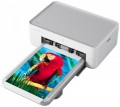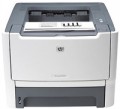Product type
—
Portable. This category includes printers of small size and weight, equipped with their own autonomous power sources. All this makes it easy to transport the device with you and use it even in the absence of sockets. Often, these models are equipped with a Bluetooth module (see "Data Transfer") for easy connection to a laptop or even a smartphone. On the other hand, the functionality of portable printers is noticeably more modest (for example, the format usually does not exceed 10x15), and the price is higher than that of stationary ones. Therefore, you should specifically look for such a model only if mobility is important to you.
Print formats
The largest paper size that the printer can handle. Most often, the formats are marked from A0 to A10; it is from here that the famous “A4” is taken, denoting a standard landscape sheet. Modern printers can use the following formats:
A2 — 420x594, the size of a newspaper spread. The largest format used in today's consumer-grade printers. In fact, this size is rarely required, and the printers themselves are expensive; therefore models under A2 are usually high-end professional devices.
A3 — 297x420 mm (2 times larger than the landscape sheet, magazine spread). It is mainly used in the business area for printing large letterheads, brochures, announcements, posters, etc.
A4 — 210x297 mm, standard landscape sheet. The most common paper size for home and office use — usually this size is sufficient for non-specialized printing.
A6 — 105x148 mm (a quarter of the landscape sheet). Printers of this format are usually designed primarily for printing photographs — the sheet size is approximately equal to the size of a standard print of 10x15 cm.
A8 — 52x74 mm, an extremely miniature format, which is 1/16 of the popular A4 (comparable to the size of a standard business card — only a little shorter). It is found mainly among portable printers (see "Type"), including models with specific printing tech
...nologies (on special paper without the use of dyes).
Note that the media format specified in the specifications is rather conditional: many printer models do not have length restrictions — the main thing is that the media fit into the width, and in some devices the actual maximum size is somewhat different from the standard sizes of a certain format.Print type
—
Inkjet. With inkjet printing, an image is applied to paper using microscopic drops of ink directed by the print head. This technology is well suited for home use and colour printing: inkjet printers are relatively inexpensive, and print quality can be as high as photographic. On the other hand, such printers are not suitable for printing in large volumes, because. the resource of cartridges is small and the price per page is quite high. In addition, if left idle for several days, ink residue in the print head will dry out, degrading print quality. This can be avoided by using the printer continuously or by using a special cleaning procedure that does not improve cartridge yield.
—
Laser. Printing in such printers occurs as follows: a laser beam marks individual sections of the photosensitive drum, toner (powdered paint) sticks to these areas, which is then transferred to paper. Laser printers are more expensive than inkjet printers and are overwhelmingly black and white; at the same time, they provide high quality and permanence of black and white printing at a low cost of the print itself, which is why they are considered optimal for business documents. Colour printing using laser technology is rarely used. inferior in quality to inkjet.
—
LED. Printing technology, in many ways similar to laser (see above); the only key difference is the use of a strin
...g of LEDs instead of the actual laser. This allows you to keep the main advantages of laser technology (quality and durability of black-and-white prints at their low cost), slightly reducing the cost of the printers themselves.
— Sublimation. In such printers, a special ink ribbon is used to form an image, and the print head is a set of heating elements. During the printing process, the head heats up the ribbon, the ink evaporates and settles already on the paper. Printing takes place in several stages, at the last one a special protective coating is usually applied to the image. This technology allows to achieve high-quality colour reproduction, a very small size of one dot and, as a result, high resolution, and therefore will be used mainly in photo printers.
— Solid ink. As the name implies, the ink for such a printer is initially in a solid state. When printing, they are heated to become liquid and applied to paper through a special heated drum (as in laser printers) or directly (like inkjet printers). Prints from a solid ink printer are distinguished by high-quality colour reproduction and resistance to moisture. On the other hand, the resolution of such devices is lower than that of inkjet printers, and the prints fade quickly enough in the light and are sensitive to scratches. Another feature is that the printer takes a portion of the dye from the cartridge every time it is turned on, and if there was no printing, this dye does not return to the cartridge when it is turned off, but is dumped into a special container as unsuitable for further use. Thus, ideally, a solid ink printer should not be turned off at all. Therefore, such devices are mainly used for professional printing in design and advertising firms.
— Thermal printing. Printing technology based on the effect of heat on sensitive media (usually special paper): the media darkens at the point of heating. Due to this, such printing does not require ink — the only “consumable” is the heat-sensitive paper itself; in addition, the design of the printers themselves is much simpler and more compact than with other technologies. However, on the other hand, the need for special paper and incompatibility with regular paper can create some difficulties; and, usually, there is no talk of colour printing. As a result, thermal printing is mainly used for official documents like checks: in cash registers, ATMs, payment terminals, etc. Printers using this technology are usually compact devices designed for maximum portability. They are well suited for those who often need to print documents out of the office — for example, forwarders, service workers, etc.Output type
The number of colours the printer produces when printing. To date, there are
monochrome(black and white) and
colour(providing full-colour printing) printers. The former are considered optimal for documents and other official materials that do not require colour; the latter allow you to create a full-fledged image, but such printing is much more expensive, so you should pay attention to them only if the colour format is critical.
Number of colors
The color palette that the printer can print.
A large number of colors is required for high-quality photo printing and obtaining color prints with many shades. The standard is
4 colors.
Max. resolution
The maximum resolution of the image to be printed. It is usually indicated by two numbers denoting the number of dpi (DPI) horizontally and vertical:
600x600, 1200x600,
1200x1200,
2400x600,
2400x1200,
4800x600,
4800x1200,
4800x2400,
5760x1440,
9600x600,
9600x2400. The detail of the image depends on this parameter - the higher the resolution, the more fine details the printer is able to convey and the better their image will be. High print resolution is important, first of all, when working with graphic material; low resolution is sufficient for high-quality text display. So
First page print time
The time from the receipt of a print command to the exit from the printer of the first page printed in black and white, in other words, how long after pressing the "Print" button, the user will receive the first page. Most often indicated for draft (fastest) print mode, higher quality will take longer. You should pay attention to this parameter if you often need to print small documents (on one or several pages) on the printer.
Mono print
The black and white print speed provided by the printer. It should be noted that this parameter is often indicated for low quality when the device is running at maximum performance; at a higher quality (even at standard), the actual speed can be noticeably lower, so you should choose with a certain margin. Also note that high speed significantly affects the price, power consumption and noise level. Therefore, it does not always make sense to chase maximum performance — for simple applications (for example, at home or in a small office), a relatively slow and inexpensive device may be the best choice.
As for specific values, speeds
up to 20 ppm are considered relatively low,
20 – 30 ppm — average,
31 – 40 ppm — decent, and the fastest models are capable of delivering
more than 40 pages per minute.
Photo print
Printer print speed in photographic (highest) quality. Unlike other similar parameters, in this case the speed is usually indicated for a 10x15 sheet (A6, the most popular format for photographs). In addition, photo printing speed is not expressed in pages per minute, but in seconds per page, because. printing takes a lot of time. This option is worth paying attention to if you plan to
print photos frequently.

